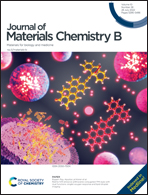A porphyrin-triazatruxene dyad for ratiometric two-photon fluorescent sensing of intracellular viscosity†
Abstract
By combining an electron-rich triazatruxene unit (TAT) to an electron-deficient zinc porphyrin fluorophore (ZnPor) via an ethynyl bridge, a new two-photon fluorescent viscosity rotor (TAT-ZnPor) with typical donor-π-acceptor (D-π-A) electronic configuration was developed for the ratiometric two-photon fluorescent detection of intracellular viscosity. The TAT-ZnPor dyad exhibited highly improved fluorescence quantum yield (Φem = 0.40) and two-photon absorption cross-section (δTPA = 811 GM) in comparison to the individual components. In the methanol/glycerol system, TAT-ZnPor showed sensitive fluorescence responses toward the change of viscosity. Upon elevating the viscosity from 0.59 to 947 cp, the blue emission band around 410 nm gradually enhanced, while the red band at 647 nm concomitantly quenched, leading to a remarkable intensity ratio (I410/I647) change from 0.70 to 81 (116-fold). TAT-ZnPor also displayed good cell imaging performance under one- and two-photon excitation, and strong mitochondria targeting ability in living cells, thus was successfully applied in detecting the change of mitochondrial viscosity during the nystatin-induced degeneration.



 Please wait while we load your content...
Please wait while we load your content...